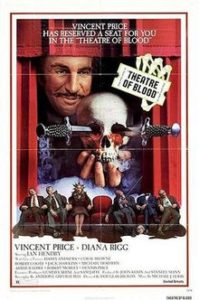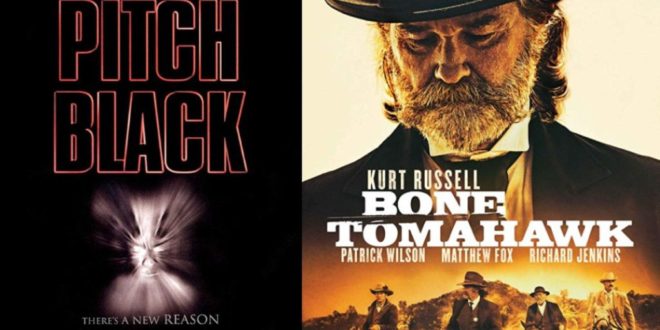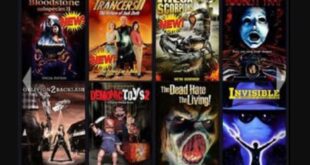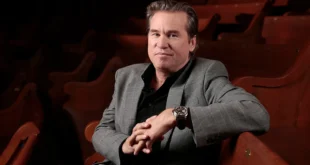Welcome to a new series where, every week, PopHorror picks a horror movie and tries to find a risky or unexpected double feature. We write up our reasons then take to social media to find out if our pick is a great night at the theater or a disappointing double bill! Will It Work? See a few of our other choices: Midsommar and Two Thousand Maniacs!, Get Out and The Devil’s Advocate, Halloween and No Country For Old Men
As a kid, or, more specifically, as a kid with an esoteric taste in horror, I ended up introducing a lot of my classmates and friends to films they wouldn’t have seen on their own. I once hosted a pool party in middle school where, after the soda and chips whipped everyone into a frenzy, I called them all in front of the TV and switched on Douglas Hickox’s Theatre of Blood (1973).

Over the opening credit montage of Shakespearean deaths, I realized that, as much as I love Hickox’s Shakespeare-flavored revenge slasher, it might be an acquired taste. When Vincent Price starts force-feeding a theater critic a pie made from his prized poodles, I looked around and saw a room full of 7th graders with facial expressions like a toddler taking a sip of beer. No matter how good it is, if it’s too early, they’re disappointed that it doesn’t taste like juice.
Horror isn’t for pool party kids or comfortable couches. It’s an uncomfortable genre that takes people on brutal, dark, unforgiving journeys. In fact, it’s not a genre. It’s a frontier, and you’re either hardy enough to make a home in it or not. This hard truth about horror and the people who survive it inspired this week’s double feature, which I’m pretentiously calling:
A Night On The Frontiers Of Fright!!!
The wild West and the big black expanse of space have shared pop culture DNA for decades. Both involve desperate, bold people stepping out and away from modern society into a wild, unforgiving expanse. They also exist amidst the neglect of unspeakable atrocity as westerns are made possible by the exploitation of millions of indigenous Americans, and space travel by definition leaves behind the planet we’re so enthusiastically burning to death. Allow me to introduce Pitch Black (2000) and Bone Tomahawk (2015 – read our review here). One is an escape into the past, the other into the future, and yet both of these cruel little films shatter that escapist fantasy with the bitter truth that, maybe, in these virgin lands, we don’t belong.

Spending an evening in the savage company of David Twohy’s gritty alien creature feature and S. Craig Zahler’s staggeringly violent western feels like striking out into a bold, new territory, all within the already new territories of the horror western and horror sci-fi subgenres.

Pitch Black follows a transport vessel after it has crash landed on a hostile alien planet. Complicating things are the film’s iconic anti-hero, the born killer, Riddick (Vin Diesel: Fast & Furious franchise), the lawman, Johns (Cole Hauser: Dazed and Confused 1993), who’s determined to bring Riddick to justice, and the grieving pilot, Fry (Radha Mitchell: Silent Hill 2006), who lost most of her crew in the crash. When the planet’s three suns finally go down, the land comes alive with flying, flesh-eating monsters, and the crash survivors have to fight for their lives.
Bone Tomahawk, on the other hand, follows Hunt (Kurt Russell: The Hateful Eight 2015), the sheriff of a small Western town, along with an assortment of the town’s menfolk as they set out to find their recently abducted doctor and save him from a cannibalistic, monstrous group of hill-dwellers.
The western and the science fiction films both run on hope and anxiety in equal measure. Many of Pitch Black’s transport occupants are seeking a better life on the other side of the galaxy. One man, an Imam (Keith David: The Thing 1982), is taking his family to New Mecca on an intergalactic Haaj. Other passengers are transporting their riches to a new home. The plot takes these skyward dreams, and literally sees them crash and burn. The hope of better things and the anxiety of losing them alchemize into the characters’ will to survive the night on this planet that would sooner see them swallowed by the land.

While Pitch Black’s low budget might suggest that the monsters are covered in darkness for practical reasons, it serves the thematic purpose of making them synonymous with the night itself, as if they are closer to weather than to some alien beast. The land doesn’t want these people to take it and or more of space littered with their dreams.
Back in Bone Tomahawk’s old West, the cannibals, called troglodytes, that plague our heroes are coated in dust from the landscape. They speak no clear, discernible language, and instead, communicate in shrieks and roars. Troglodytes are literally connoted to mean primal, cave-dwelling people. These killers in the hills are, by name and appearance, reflections of the land itself. They kill and eat these bold frontiersmen for no greater reason than because they are there. The cannibals infiltrate the town, literally called Bright Hope, and steal the town’s doctor, not for his knowledge but for his meat. The land, wild and brutally utilitarian, has no place for thought, education, and the preservation of life or hope.

The creatures in the night and the troglodytes stand as elemental obstacles to people who wish to find a future for themselves, whether on a spaceship or in their town. Watching the two films together, you are forced to confront the delicate and dangerous question of whether or not they deserve that future. By extension, you must ask yourself if humanity itself deserves a place on the frontier, or if the future is better off with our Bright Hopes snuffed out in a Pitch Black night.
So, what do you think… a double feature of Pitch Black and Bone Tomahawk… will it work?
 PopHorror Let's Get Scared
PopHorror Let's Get Scared




